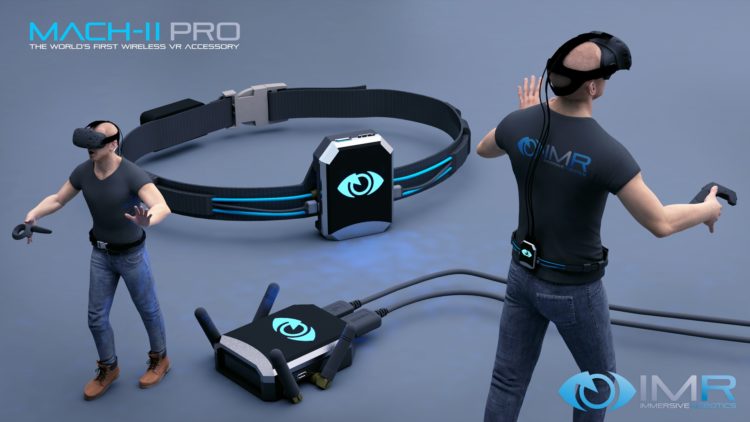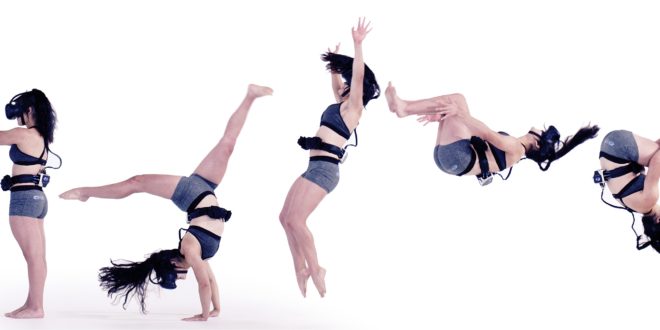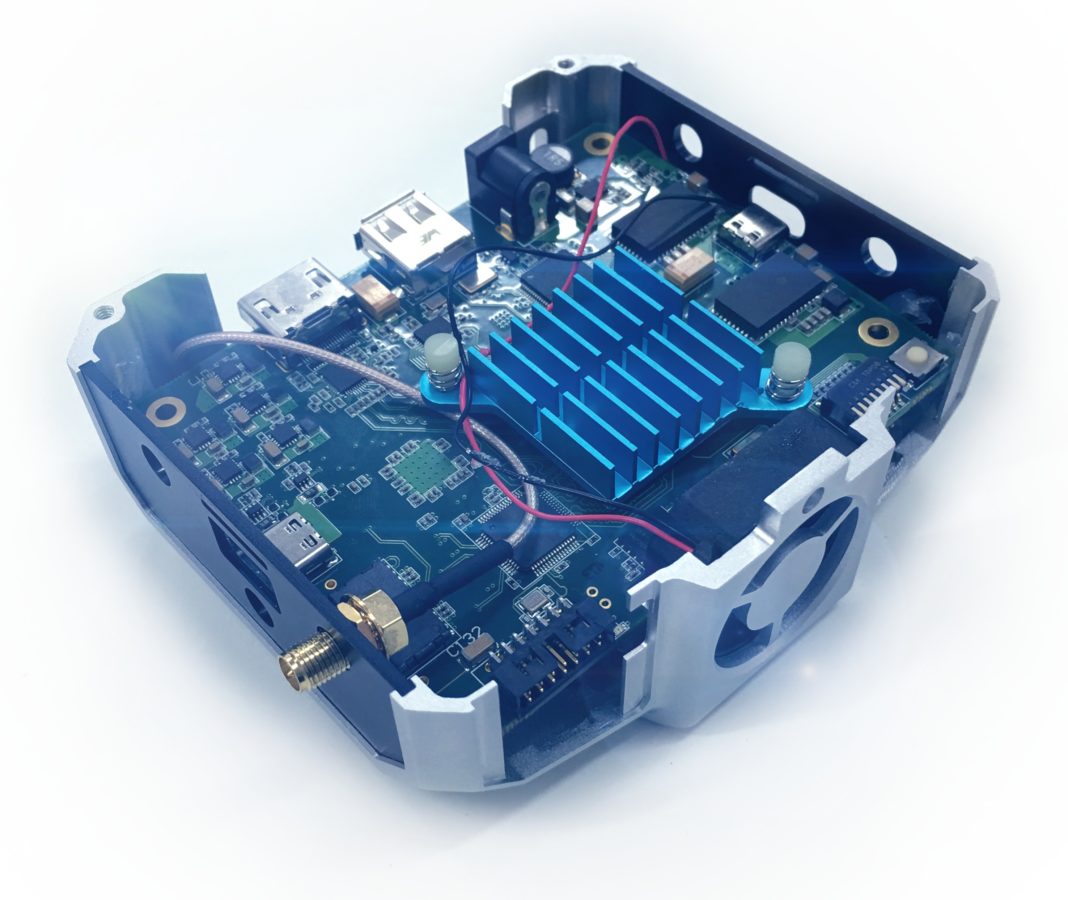There have been a lot of companies to try and say they are providing the true tether-free experience, but the truth of the matter is that these companies are tackling, perhaps, the easiest part of the problem. Let’s go over what Immersive Robotics have created and why many technology articles will rave about it before we get into why what they’re doing is the easiest part of the problem.
Wireless 4K Per-Eye Video System
The stats are pretty impressive with the ability to host 4k resolution per eye in the future running on a 5 Volt power supply and working with vanilla WiFi. Yes, that’s all very impressive and they have also managed to make a new algorithm that takes an image, compresses it, and then also decompresses it utilizing two different boards. The system is called the Mach-2k and has actually been downgraded so that it can play nice with the HTC Vive. That’s all very well impressive, but once again this is an attachment to your current headset rather than replacing the headset altogether.
Why is there such a Hype About the Mach-2k

Well, to be honest, a lot of individuals in the tech industry love optimization. It’s similar to how people who like cars hear about a new engine and get all excited, but the reality is that this is the natural progression of currently existing technology. The company originally designed this for use in drones so that one could have a better look at the area that they are in, but the founders eventually realized how their concept could be worth something in the consumer market of VR for everyone. This is one of the rare companies that was funded by the government for their original work and found out their work could be utilized in other areas utilizing similar technology.
Why This is the Easiest Part
Once again, let’s look back at the car as our example because the issue with global warming is a good example. Our new cars can handle anywhere from 40 – 60 mpg, which is an impressive improvement when compared to cars of the past. This is something that some car enthusiasts love to brag about. However, this does not solve the problem that cars create a huge amount of the contribution to environmental change. All it does is postpone solving the actual problem to the entire equation, which is that we turn to alternative fuels and start repairing the atmosphere.

With no-tether technology, the issue is very similar in that it is only postponing the problem, which is that VR technology simply takes up a lot of power to run. Any decent programmer with decades of experience, like those of this company, can pump out an algorithm capable of reducing the load that has to be transferred over a wireless connection. In all actuality, all they are doing is sending the instructions in such a way that there is very little memory overhead while compiling the program. The only problem is that such a development would take a long time to think through mathematically and program it into the board. Do not confuse my words when I say this is the easiest part because this part is still really difficult to do.
We’ve already discussed what the problems of VR are in previous articles, but let’s sit down and spend some time actually talking about them. As I see it, there are three main problems with current VR technology and almost none of them have anything to do with wireless transmission.
* Staggered Rendering
* Upscaling and Downscaling
* Positional Framing
Let’s talk about staggered rendering first, which is the category that fits your line of sight and distance of sight into one ball. On a PS4, Xbox 360, and a Nintendo 64 we all had the same problem in that the graphics were simply too powerful to load at one time. When Watchdogs came out it received an enormous backlash for some of its sluggish gameplay due to an attempted optimization the team put on their discs. In order to save on the cost of hardware that went into a machine, gaming companies had to conform to the restrictions that the console companies put forth and the solution was called Staggered Rendering.

When you load a map for the first time, you are not loading everything in the map. Instead, you are only loading what is a specific distance away. The effect of this is massive on a computer’s GPU, the unit specifically designed to handle graphics. If a console were to load something like Watchdogs all at once then you would have a console that bursts into flames or it would just shut off as it would simply be too many GB for the CPU and GPU to handle. The current version of the game only loads about 50-100 feet in the game, which takes up around 4GB of RAM and a decent pick of a CPU and GPU. In Virtual Reality, I have not seen this implemented and developers are still having a problem with the rendering as it makes people sick. The reason why these games feel like arcade games and why such a small set of video games need to be supported by monstrous hardware is because there isn’t any staggered rendering yet.
Do you really think it is that difficult to create a virtual reality experience? It’s like if you put two tiny television screens playing a first person shooter game up to your eyeballs. I know that I just took a plane and flew over the definition of simplifying, but that generally sums up what makes VR work. Oh wait, we already have that in the form of Cardboard and Gear VR. The biggest problem of them all is not the wireless issue but rather the rate at which the game is rendered.
This goes hand in hand with positional framing, which is when a game only loads what can be seen on the screen. Some games utilize this but it won’t make a huge impact because of staggered rendering if your game doesn’t already have GPU intensive elements. Combining positional framing and staggered rendering in VR would make it possible to put on the Gear VR and simply play using that. At that rate, any phone that could handle 1080p/4k/8k resolution could be used instead of a headset like the Vive.
At this point, making the VR system a wireless one would not be incredibly difficult and while the Mach-2k is designed to handle the current poorly-optimized version of VR it would be overkill in a situation where proper optimization was put into the game. This does not negate the fact that these games still require the capacity to render at such a resolution, but this can be fixed with upscaling and downscaling. We already see companies attempting to fix it this way, such as PlayStation’s non-native 4k.
The Good News
This isn’t a negative article, but rather a look into the real problems of the VR world rather than overhyping a technology that is being done by several other companies at the same time. There is good news with the talk of their algorithm though as it gives a taste of how we could provide staggered rendering. Their codec provides a way to compress and uncompress at an astronomical rate, which is sort of how staggered rendering works.
In staggered rendering, you could theoretically compress all the information the player has yet to come into view of and uncompress as needed. This would be a much more difficult task as it would require a lot more logic behind the codec but it could be done. If this were the first step to be implemented towards staggered rendering then we could easily see VR game requirements drop to the common console and PC game requirements we see today. Additionally, there would finally be quality settings for VR games but such features are philosophical in nature and unpredictable due to the aspects of VR.
The device that the Mach-2k represents is not that impressive, it is the algorithm underneath the device that makes it work that could give us the first step of staggered rendering to lower the graphical requirements of VR systems. Lowering the graphical requirements would allow for a higher adoption rate amongst consumers and thus coming back full circle to boost the VR industry into further progress.
What The Mach-2k and Our Discussion Has To Do with Fitness
As of right now, the average person’s phone simply can’t handle the games we see available to the VR market. The games simply require too much power from a main source and you can’t easily hook your phone up to your computer to simulate the experience of the Vive just yet. However, if we implement staggered rending by itself along with the Mach-2k wireless transmission device then it is possible that we could see full-fledge games for the VR come out on the mobile platform. This would include fitness games that you could simply take out of your pocket and go straight into fitness. It would be the true experience that fitness individuals have been waiting to receive from the VR world.

This may all be speculation, but speculation is good and the average consumer isn’t the only one reading such articles. As a developer, it is a common practice to tell new developers that they subscribe to news sources in their field that cover the subject they develop in. This means that speculative VR/AR/MR articles are often read by the people who develop those very technologies, which is why it is important to share such speculation with them. Technology writers and consumers like you are the reason why technology companies consistently improve.





